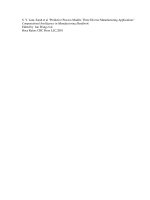Computational Intelligence In Manufacturing Handbook P9
Bạn đang xem bản rút gọn của tài liệu. Xem và tải ngay bản đầy đủ của tài liệu tại đây (505.25 KB, 27 trang )
Zhang , Y. F. et al "Application of Genetic Algorithms and Simulated Annealing in Process ..."
Computational Intelligence in Manufacturing Handbook
Edited by Jun Wang et al
Boca Raton: CRC Press LLC,2001
©2001 CRC Press LLC
9
Application of Genetic
Algorithms and
Simulated Annealing
in Process Planning
Optimization
9.1 Introduction
9.2 Modeling Process Planning Problems
in an Optimization Perspective
9.3 Applying a Genetic Algorithm
to the Process Planning Problem
9.4 Applying Simulated Annealing
to the Process Planning Problem
9.5 Comparison between the GA and the SA Algorithm
9.6 Conclusions
9.1 Introduction
Process planning represents the link between engineering design and shop floor manufacturing. More
specifically, it is the function within a manufacturing facility that establishes the processes and process
parameters to be used in order to convert a piece-part from its original form to a final form that is
specified on a detailed engineering drawing. For machining, process planning includes determination of
the specific operations required and their sequence, which include tooling, fixturing, and inspection
equipment. In some cases, the selection of depth of cut, feed rate, and cutting speed for each cut of each
operation is also included in the process planning for a part. Due to the advent of computer technology
and great market need for short production lead time, there has been a general demand for computer-
aided process planning (CAPP) systems to assist human planners and achieve the integration of computer-
aided design (CAD) and computer-aided manufacturing (CAM). Moreover, the emerging product design
practice employing the design for manufacturing (DFM) philosophy also needs a CAPP system to generate
the best process plan for a given part for manufacturing evaluation. In general, a CAPP system is required
to be able to provide the following supporting roles to design and manufacturing:
1. Capable of conducting manufacturability assessment on a given part and generating modification
suggestions for the poor design features.
Y. F. Zhang
National University of Singapore
A. Y. C. Nee
National University of Singapore
©2001 CRC Press LLC
2. Capable of generating the best process plan for a given part based on available machining resources
in the shop floor. The term “best” refers to a plan that satisfies a predetermined criterion.
3. Capable of generating alternative process plans to suit production scheduling needs and/or changes
in the shop floor status.
Over the last 20 years, there have been numerous attempts to develop CAPP systems for various parts
manufacturing domains, such as rotational and prismatic parts. The levels of automation among the
reported systems range from interactive, variant, to generative [Alting and Zhang, 1989]. The discussion
in this chapter focuses on the generative type as it is the most advanced and preferred. In general, the
main characteristics of those reported generative CAPP systems, in terms of various decision-making
activities in process planning, can be summarised as follows:
1.
Machining features recognition
— The workpiece, both the raw material and finished part, is
generally given in a solid model representation. The difference between the finished part and the
raw materials represents the volumes that need to be removed. The total removal volumes are
extracted and decomposed into individual volumes, called machining features (e.g., holes and
slots), which can be removed by a certain type of machining process (e.g., drilling and milling).
2.
Operations selection
— For each machining feature, an operation or a set of operations (e.g.,
roughing and finishing operations) is selected.
3.
Machines and cutters selection
— For each operation, a machine and a cutter are assigned to it
for execution, based on shop floor resources.
4.
Set-up plan generation
— A
set-up
refers to any particular orientation of the workpiece on the
machine table together with a fixture arrangement where a number of operations can be carried
out. The tool approach direction (TAD) for each operation is determined. A set-up is determined
based on the commonality of TAD and fixture arrangement for several operations.
Most reported CAPP systems carry out decision-making activities 2 through 4 in a linear manner, and
each is treated as an isolated deterministic problem (see Figure 9.1(a)). Such systems can only generate
a feasible process plan by going through one or several iterations of decision-making due to possible
conflicts among the different selection results. As a result, they found little industrial acceptance, as the
plans generated are far from optimal. The main reasons behind this are
1. For each decision-making problem, the feasible solutions are most likely many but one. Selecting
only one solution from each problem leads to premature reduction of the overall solution space
and hence the optimal selection combination may well be lost on the way to the final solution.
2. The decision-making problems are interrelated rather than independent of each other. The linear
decision-making strategy may create various conflicts that result in many iterations.
In conclusion, these decision-making problems must be considered simultaneously in order to achieve
an optimal process plan for a given part (see Figure 9.1(b)). Recently, the authors have noted that some
CAPP approaches have been designed to tackle the problems mentioned above by partially integrating
the decision-making activities [Chen and LeClair, 1994; Chu and Gadh, 1996; Yip-Hoi and Dutta, 1996;
Hayes, 1996; Gupta, 1997; Chen et al., 1998]. However, full integration has not yet been achieved.
When all the decision-making problems are considered simultaneously, process planning becomes a
combinatorial problem. Even for a problem with a reasonable number of machining features, it is
impossible to check every possible solution. Efficient search algorithms must be developed to find the
optimal or near-optimal solution.
In this chapter, a novel algorithm that models process planning in an optimisation perspective is
presented. The application of genetic algorithms and simulated annealing to solve the process planning
model are discussed together with a case study.
©2001 CRC Press LLC
9.2 Modeling Process Planning Problems in an Optimization
Perspective
9.2.1 The Process Planning Domain
The process planning domain for a CAPP system is defined by the types of parts, machining features, and
machining environment it deals with. The discussion focuses on prismatic parts. The geometry of a part
is represented as a solid model created using a CAD software. The raw material is assumed to be a pre-
machined prismatic block that just encloses the part (a convex hull). The basic machining features, which
can be used to construct the most commonly encountered prismatic parts, are shown in Figure 9.2. Some
of these simple features can be merged together to form complex intersecting machining features. As for
the machining environment domain, a CAPP system should be flexible enough to handle common parts
in traditional job shops. In this discussion, the job shop information in terms of its machining capability
and current status is treated as user input through an open architecture, to update the currently available
machining resources (machines, tools) along with their technological attributes such as the dimensions
FIGURE 9.1
Two typical CAPP approaches.
Operations? Machines?
Cutters?
Fixtures?
Set-ups?
Machining
features
Machining
features
Operations? Machines & Cutters? Fixtures & Set-ups?
(a) Process planning in a linear manner.
(b) Process planning in a concurrent manner.
©2001 CRC Press LLC
limits, achievable accuracy and surface finish. The machines used include conventional machines (e.g.,
horizontal and vertical milling, drilling, and grinding) and CNC machining centers.
9.2.2 The Process Planning Problem
Given a part and a set of manufacturing resources in a job shop, the process planning problem can be
generally defined as follows:
1.
Operations selection
— For each machining feature, determine one or several operations required.
This includes the selection of machines, tools (cutters), TADs, and fixtures based on the feature’s
geometric and technological specification and available machining resources. This process can
also be categorized into two substages: operation type selection and operation method selection.
An operation type (OPT) refers to a general machining method without concerning any specific
machines and tools (e.g., end-milling and boring). An operation method (OPM), on the other
hand, refers to the machine and tool to be used to execute an OPT. It is a common practice for
human planners to make decisions over these two stages simultaneously.
2.
Operations sequencing
— Determine the sequence of executing all the OPMs required for the
part so that the precedence relationships among all the operations are maintained. Set-ups can
then be generated by clustering the neighboring OPMs that share the same machine and fixture
arrangement.
It is obvious that decisions made in steps 1 and 2 may contradict each other. Therefore, the decision-
making tasks in 1 and 2 must be carried out simultaneously in order to achieve an optimal plan. For
FIGURE 9.2
Basic machining features.
Step
Simple hole
Throughslot
Notch C-bore hole
Blind slot
Chamfer
Sink-bore hole
T-slot
Boss
Pad
Dovetail slot
U-slot
Ball-end-slot
Blend
Round pocket
Rectangle pocket
©2001 CRC Press LLC
each of the decision-making tasks described above, process planning knowledge at both global and local
levels is required, which is described in the following subsections.
9.2.2.1 OPT Selection
OPT selection is carried out by mapping each machining feature to one or a set of OPTs, based on
feature’s type, dimensions, tolerance, and surface finish. Feasible solutions can be multiple. For example,
the OPT for a through hole of 20 mm in diameter without any tolerance and surface finish requirements
is by drilling only, where as the OPT for the same hole but with a surface finish of 3.2
µ
m can be either
(drilling, reaming) or (drilling, boring).
9.2.2.2 Machine (M) and Cutter (T) Selection
For each OPT, a machine and cutter can be selected from the available machined and cutters in the job
shop, based on the geometry and accessibility of the feature to which the OPT is applied. Similarly,
feasible solutions can be multiple. If no such machine or suitable cutter can be found to perform the
OPT, it is eliminated. For example, an end-milling operation is selected for F1 (pocket) in Figure 9.3. A
feasible end-mill cutter must have sufficient length to reach the bottom of the pocket and its radius is
no more than the corner radius of the pocket.
9.2.2.3 TAD Selection
A TAD for an OPM refers to an unobstructed path along which the tool can approach the feature to be
machined. Similarly, feasible TADs for an OPT(M/T) can be multiple. For a prismatic part, six possible
TADs, i.e., the six normal directions of a prismatic block (
±
x
,
±
y
,
±
z
), are assumed. For a cutter acting
on a feature alone, its theoretical TADs are fixed. However, interference may occur when considering the
part and tool geometry. One of the approaches to check such interference is to simulate the movement
of the cutter in a solid mode [Ma, 1999]. The solid model of a tool is moved from a predefined path
toward the feature along its theoretical TADs. After reaching the feature, it is moved to cover the entire
feature. During this simulation, any TAD that causes interference is discarded. If an OPT(M/T) does not
have any feasible TADs, it is discarded. Referring to the part shown in Figure 9.3, although drilling a
through-hole has two TADs in theory, a drill can only approach F5 along “+
x
.”
FIGURE 9.3
A machined block.
F4(Step)
F8(Hole)
F7(Chamfer)
F6(Step)
F2(Slot)
z
y
x
A
0.01 A
F9 (Slot)
F10 (Slot)
©2001 CRC Press LLC
9.2.2.4 Fixture Selection
Fixtures are mechanical devices used to secure a workpiece on the machine table during machining. For
machining of prismatic parts, modular fixtures and vices are the most common fixture devices [Nee et
al., 1995]. For an OPT(M/T/TAD), the workpiece geometry is checked to see if a particular fixture can
be applied. A vice needs two parallel faces vertical to the machine table while a modular fixture needs
three orthogonal faces based on the 3–2–1 principle. Since the workpiece geometry is a result of the OPT
sequence, fixture selection can be done during operations sequencing.
9.2.2.5 Precedence Relationships between Operations
Although a possible process plan can be a permutation generated from the OPM pool, it is considered
valid only if none of the precedence relationships (PRs) between operations caused by geometrical and
technological consideration need is violated. In other words, these PRs have to be identified to check if
a randomly generated sequence is valid. In general, the PRs between operations can be identified from
the following:
1.
PRs between the realisation of machining features
— These can be derived from process con-
straints such as fixture constraint, datum dependency, and good machining practices. Some typical
process constraints considered are as follows:
•
Fixture constraint:
A PR between two features exists when machining one feature first may
cause another to be unfixturable. An example is given in Figure 9.3 where F2 must be milled
before F1, F3, F4, F6, and F7. Otherwise, the supporting area for milling F2 is not sufficient.
•
Datum dependency:
When two features have a dimensional or geometrical tolerance relation-
ship, the feature containing the datum should be machined first. For example, F4 needs to be
machined before F6 since the side face of F4 is the datum of F6 (see Figure 9.3).
•
Parent–child dependency:
When a feature (A) must be produced before a tool can access another
feature (B), A is called the parent of B. For example, F9 can only be machined after F2 is
produced (see Figure 9.3).
•
Avoiding cutter damage:
For two intersecting features A and B, if machining B after the creation
of A may cause cutter damage, B should be machined first. Referring to Figure 9.3, if F8 is a
blind hole, it should be drilled before F7 in order to avoid cutter damage. However, if F8 is a
through hole, this PR does not hold if “+
z
” is chosen as the TAD for drilling F8, provided that
the slot F2 is not too deep
•
Better machining efficiency:
For two intersecting features A and B, machining either one first
may partially create the other. If machining A has a larger material removal rate (e.g., an end-
mall cutter with a larger diameter) than machining B, A should be machined first. Referring to
Figure 9.3, the machining of F4 and F10 is intersected. As F10 can only be machined using an
end-mill cutter with a much smaller diameter than that for F4, F4 should be machined before
F10.
2.
PRs among a set of OPTs for machining a feature
— For every set of OPTs obtained through
mapping from a feature, there exists a fixed PR among those OPTs, i.e., roughing operations come
before finishing operation (e.g., drilling comes before reaming, milling comes before grinding,
etc.).
Since the PRs generated based on the above considerations may contradict each other, they can be
categorized into two types: the
hard
PRs and
soft
PRs. The part cannot be manufactured if any of the
hard PRs are violated; while the part can still be manufactured even if several soft
PRs are violated,
although the practice is less preferred. For example, for the part in Figure 9.3, the PR of F2
→
F9 is a
hard one, while the PR of F4
→
F10 is a soft one. By categorizing the PRs into hard
and soft ones, a
feasible process plan can be achieved when conflicts between the hard PRs and soft PRs arise. Generally,
a well-designed part will not present any conflicts between hard PRs.
©2001 CRC Press LLC
9.2.2.6 Relationships between OPMs and the Sequence of OPMs
Although operation methods selection and operation methods sequencing need to be carried out simul-
taneously, in actual operation execution, one is carried out before the other, without considering the
result of the latter. To maintain the concurrency between these two activities, the validity of the result
from the latter must be checked and ensured to satisfy the result from the former. Depending on which
one (OPMs selection or OPMs sequencing) is executed first, the validity of OPMs and a sequence of
OPMs is discussed as follows:
1.
Validity of a sequence of OPMs (OPMs selection first)
— The validity of a sequence of OPMs
refers to the PRs among the OPMs are satisfied. The influence of selecting OPMs first on the
validity of a sequence of OPMs can be seen from the variation of PRs caused by the selected OPMs.
In other words, some PRs are invariant regardless of the OPMs selection, while others are the
results of the OPMs selection. Referring to Figure 9.3, if F8 is a blind hole, it should be drilled
before F7 as discussed previously. However, if F8 is a through hole, this PR does not hold if “+z”
is chosen as the TAD for drilling F8, provided that the slot F2 is not too deep. This indicates that
sometimes the validity of a PR depends on the selection of TAD or OPMs. These kinds of PRs
are designated as
conditional
PRs and the conditions are attached to them. When OPMs are selected
first, the conditional
PRs can be validated.
2.
Validity of OPMs (OPMs sequencing first)
— The validity of an operation method refers to the
feasibility of applying its M/T/TAD under particular circumstances. For instance, an
OPT(M/T/TAD) certainly depends on the availability of the M and T, which are naturally ensured
during the OPMs selection phase. When a sequence of OPMs (OPM templates, actually) is selected
first, some of the TADs identified earlier for the OPMs may become invalid. Referring to Figure
9.3, F8 (through-hole) has two alternative TADs, i.e., “+z” and “–
z
.” If OPM(F7) precedes OPM(F8)
in a preselected sequence, OPM(F8) with “–
z
” will be invalid. This indicates that sometimes the
validity of a TAD or OPM depends on the sequence of OPMs. These kinds of TADs are designated
as
conditional
TADs and the conditions are attached to them. When a sequence of OPMs is selected
first, the conditional
TADs can be validated, as well as the OPMs they belong to.
9.2.2.7 Grouping Effect on the Validity of OPMs
In addition, there are situations where a group of OPMs are needed for producing a feature. In that case,
the validity of an OPM may depend on its neighbouring OPM. For instance, a through hole can be
produced through (centre-drilling, drilling, reaming) from a solid part. Although drilling may have two
opposite TADs in theory, in the OPM selection for drilling, it must have the same TAD as centre-drilling
in the same group.
9.2.3 The Process Plan Evaluation Criterion
In the last section, the solution space for a process planning problem is described based on discussions
on various selection stages and constraints. It is obvious that there can be many feasible solutions for a
given process planning problem. Therefore, there is a need to find the best plan. In order to achieve this,
an evaluation criterion must be defined.
Currently, the most commonly used criteria for evaluating process plans include shortest processing
time and minimum processing cost. Since the detailed information on tool paths and machining param-
eters is not available at the stage where only operation methods and their sequences are determined, the
total processing time cannot be accurately calculated for plan evaluation. On the other hand, the pro-
cessing cost can be approximated. Generally, the processing cost for fabricating a part consists of two
parts, i.e., cost due to the usage of machines and tools and cost due to set-ups (machine change, set-up
change on the same machine, and tool change). For the cost due to machine usage, a fixed cost is assumed
every time a particular machine or a tool is used. For the cost due to set-ups, a fixed cost is assumed
when a particular set-up is required. Based on these assumptions, five cost factors (machine usage, tool
usage, machine change, set-up change, and tool change) for a process plan can be derived as follows:
©2001 CRC Press LLC
1. Machine usage cost (
MC
)
Equation (9.1)
where
n
is the total number of OPMs in the process plan and
MCI
i
is the machine cost index for
using machine
i
, a constant for a particular machine.
2. Tool usage cost (
TC
)
Equation (9.2)
where
TCI
i
is the tool cost index for using tool
i
, a constant for a particular tool.
3. Machine change cost (
MCC
): a machine change is needed when two adjacent operations are
performed on different machines.
Equation (9.3a)
Equation (9.3b)
where
MCCI
is the machine change cost index, a constant, and is the ID of the machine used for
operation
i.
4. Set-up change cost (
SCC
): a set-up change is needed when two adjacent OPMs performed on the
same machine have different part orientations. Generally, when a part is placed on a machine
table, a TAD along which an OPM approaches a feature dictates the orientation of the part.
Therefore, TADs are used to represent the required orientations of the part.
Equation (9.4)
where
SCCI
is the set-up change cost index, a constant.
5. Tool change cost (
TCC
): a tool change is needed when two adjacent OPMs performed on the same
machine use different tools.
Equation (9.5)
where
TCCI
is the tool change cost index, a constant.
The sum of these five cost factors approximates the total processing cost. On the other hand, these
cost factors can also be used either individually or collectively as a cost compound based on the require-
ment and the data availability of the job shop. For example, if a process plan with minimum number of
set-up changes is required, the evaluation criterion is set as
SCC
. This criterion setting provides much
flexibility required by different job shops.
MC MCI
i
i
n
=
=
∑
1
TC TCI
i
i
n
=
=
∑
1
MCC MCCI M M
i
i
n
i
=×
+
=
∑
Ω()
1
1
–
Ω(–)MM
MM
MM
ij
ij
ij
=
≠
=
1 if
0 if
SCC SCCI M M TAD TAD
ii i i
i
n
=×
()
()
×
()
()
++
=
∑
1
11
1
1
–– –
–
ΩΩ
TCC TCCI M M T T
ii ii
i
n
=×
()
()
×
()
()
++
=
∑
1
11
1
1
–– –
–
ΩΩ
©2001 CRC Press LLC
9.2.4 An Optimization Process Planning Model
Based on the above discussion, the solution space for a process planning problem can be explicitly formed
by all the OPTs required, the available OPMs for each OPT, possible sequences, and various constraints.
A modelling algorithm to obtain this solution space is described as follows:
Algorithm: process planning modelling
Input:
A set of features, job shop information (machines and tools).
Output:
Number of OPTs required, OPMs (M/T/TAD) for each OPT, precedence relationships
between OPTs.
1. For each feature, find all the OPTs that can achieve its attributes (shape, dimensions, tolerances,
and surface finish), based on shop level machining capabilities. The resulting OPTs for a feature
can be expressed as one or several sets of (OPT
1
, OPT
2
, . . . , OPT
k
), where
k
is the total number
of OPTs required in a set. It is worth mentioning that different sets of OPTs for a feature may
have different number of OPTs. For example, a blind hole can have two sets of OPTs: (centre-
drill, drill, ream) and (centre-drill, mill). To achieve a uniform representation, the concept of a
“dummy” OPT (D-OPT) is introduced, which is defined as an operation incurring no machining
cost and having no effects in terms of machine, set-up, and tool changes. By adding the dummy
operation into the sets that have fewer operations, each set will have the same number of OPTs.
For the above example, the two sets of OPTs for producing a hole can be expressed as (centre-
drill, drill, ream) and (centre-drill, D-OPT, mill). Finally, the total number of OPTs required for
the part is determined.
2. Identify all the PRs among features as well as among the OPTs in each set for a feature. Convert
the PRs between two features to the PRs between their OPTs according to the following rule:
IF
F(X)
→
F(Y)
AND
OPT(i)
∈
F(X)
AND
OPT(j)
∈
F(Y)
THE
OPT(i)
→
OPT(j)
As a result, both
hard
and
soft
PRs are identified. The hard and soft
PRs are compared pair-wise.
If a conflict arises, the respective soft PR in the respective conflict is deleted.
3. For each OPT, find all the combinations of machines (Ms) and tools (Ts) with which it can be
executed, based on machine-level machine capabilities.
4. For each combination of M and T, find all the feasible TADs.
5. Attach a condition to a TAD if it depends on a particular sequence or the assignment of a TAD
to a particular OPT. Similarly, attach a condition to a PR if it depends on the assignment of a
TAD to a particular OPT.
End of algorithm process planning modelling.
The output from the above algorithm is a fixed number of OPTs required for fabricating a part and
along with each OPT, one or several sets of (M/T/TAD). The PRs among the OPTs are also explicitly
represented. To further illustrate this novel process planning modelling technique, the part shown in
Figure 9.4 is used as an example. It is constructed by adding several machining features to a chuck–jaw
in order to pose certain difficulty for process planning. The dimensions and tolerances are also shown
in Figure 9.4. The machining process starts from a rectangular block. It is assumed that the block is pre-
machined to a size of 160
×
50
×
70. Therefore, the part consists of 14 features as shown in the figure.
This part is assumed to be machined in a job shop, in which the available machines are: one three-axis
conventional vertical milling machine (M1,
MCI
= 35), one three-axis CNC vertical milling machine
(M2,
MCI
= 70), one drill press (M3,
MCI
= 10), one conventional horizontal milling machine (M4,









